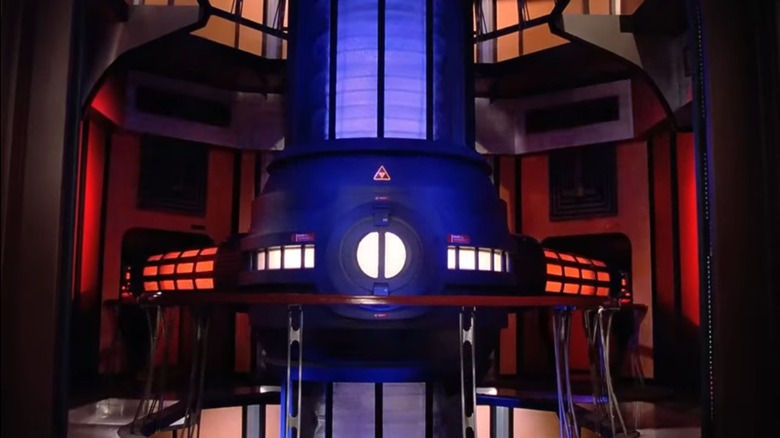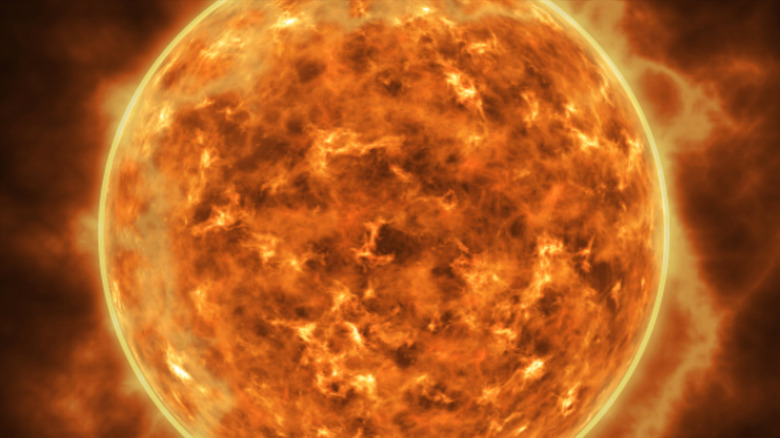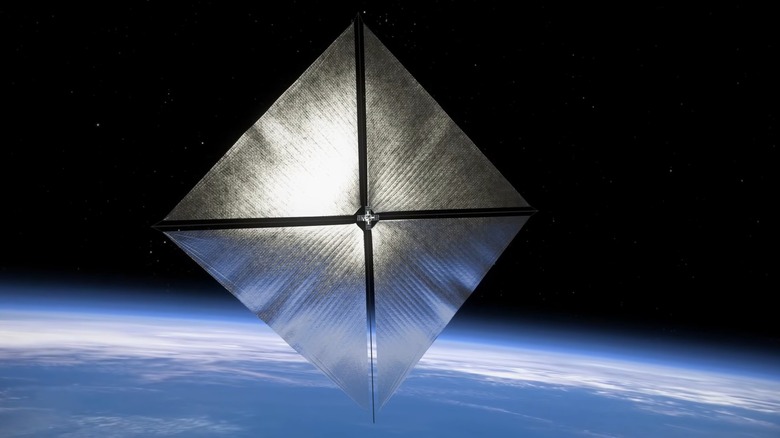The Physics Of Lightspeed Travel: Why It May Remain Science Fiction
Space — the final frontier. These are the words that introduce every episode of classic "Star Trek," the show that essentially popularized the concept of traveling the stars at the speed of light – or faster. While "Star Trek" has accurately predicted a lot of technology, its depiction of an interstellar society will probably never be realized.
So just what is preventing us? A lack of alien neighbors? Our refusal to give up money-based capitalism in favor of whatever the Federation of Planet uses? No, the answer lies in the interstellar part. We have no trouble traveling anywhere on Earth, but anything outside its atmosphere is significantly harder because it is so far away. So far, in fact, that having enough energy to make the trip and doing so in a timely manner precludes not only the journey but any inclination to develop the necessary technology. The real kicker, however, is that we will probably never overcome this problem due to the insurmountable barriers presented by real-world physics.
While there's always a chance we somehow skirt around the laws of nature as we currently know them and invent a technology that lets us quickly travel to distant stars, odds are that will never happen. I will explain exactly why this is with the help of my background in science writing and degree in engineering.
What is the speed of light?
Before we continue, we should probably define the speed of light. Granted, it is exactly what it sounds like: the speed limit for light particles. However, the implications of this limit go pretty deep.
Currently, the speed of light through a vacuum (an area devoid or almost devoid of matter) has been clocked at 299,792,458 meters per second. That's about 186,282 miles per second. When light travels through matter, it slows down, but the difference is usually imperceptible to the naked eye. Light shot through diamond slows down to only under 80,000 miles per second, but if you want to really slam on light's brakes, you need to use ultra-cold clouds of atoms.
So what's so important about the speed of light? According to Einstein's Theory of Relativity (E=mc2), nothing can move faster than the speed of light with the potential exception of galaxies. The further away galaxies are from one another, the faster they move apart. More importantly, since light has a speed limit, it also has a set distance it can travel in a year, colloquially known as a lightyear.
The further away a star or galaxy is, the longer its light takes to reach Earth, so whenever we look at distant galaxies via the Hubble Telescope, we aren't seeing them as they are now but as they were millions or even billions of years ago. It's the closest we can currently get to time travel.
The energy requirements are impossible to meet
Every object requires energy to move or be moved. The heavier the object, the more energy is needed, but terms like heavy and light don't apply to situations where gravity is absent. Instead, they rely on mass –- which also determines an object's weight –- but problems still crop up when approaching lightspeed.
In order to travel at lightspeed, we have to overcome Einstein's Theory of Relativity, which probably won't happen anytime soon. One often overlooked part of the theory, the Theory of Special Relativity, states that the closer an object approaches the speed of light, the more its mass increases. When an object travels at the speed of light, its mass becomes infinite, so in order to move it, one would need an equally infinite source of energy. Even traveling at 99.99% the speed of light would require prohibitively large amounts of energy.
Currently, the fastest man-made object in existence is the Parker Solar Probe, which traveled at an astronomical 635,266 km/h (approximately 394,736 mph) back in 2023. In 2025, the probe is projected to break that record and zoom around the sun at around 690,000 km/h. However, that is still an object too small to carry a human relying on the sun's gravity to travel at 0.063% the speed of light. Not exactly impressive, but we've all gotta start somewhere.
Humans wouldn't survive the acceleration
The force of gravity is constant, but it is also relative. Every object exhibits a gravitational pull on every other object, and when they move fast enough, they exert forces on anything inside them. Everything has a breaking point, especially the human body.
All acceleration within vehicles exerts acceleration forces on its passengers. Usually these forces are barely noticeable, but the faster you go, the higher they become. Most people can shrug off acceleration anywhere between four to six times the force of Earth gravity, which is expressed as four to six gs. Meanwhile, fighter pilots can withstand up to 9 gs but only for a short while thanks to special equipment and training. Normally, the worst anyone has to worry about is passing out, but if they continue at these speeds, pilots would risk death via asphyxiation because the gs would prevent oxygenated blood from flowing properly.
As bad as asphyxiation at 9 gs sounds, accelerating to the speed of light would be even worse, as that would subject the human body to 6,000 gs of force. This sudden acceleration would flatten passengers almost instantly. The fictional spaceships in "Star Trek" have inertial dampener systems to prevent this, but since we don't we'd need to find a safe method of acceleration if we were to actually travel at lightspeed. Hypothetically, slowly ramping up the speed at low gs would do the trick, but that would take several years, partially negating the benefits of lightspeed travel.
Time isn't on the pilot's side
The secret to virtually every interstellar civilization in sci-fi is that their stories play fast and loose with the concept of time. In reality, time isn't a constant. A multitude of factors can impact how someone perceives the flow of time, and we don't just mean if they're having fun or are bored out of their skulls.
Space is so prodigiously huge that even light itself takes countless years to bridge the distance. Traveling at lightspeed wouldn't resolve this issue, but it could offer a unique experience. The faster an object moves, the more time slows down for it. If a person were to experience this, they wouldn't notice anything different because time is slowing down for them as well, including their perception of time.
Let's say people actually could build a spaceship capable of traveling at lightspeed, and its crew set out to visit the center of the galaxy. How much food would they need? Thanks to time dilation, they would only require enough to survive a few decades, which sounds almost trivial until you read the fine print — it would be a one-way trip.
Well, technically the passengers could return, but only if they didn't mind returning to an unrecognizable Earth. While the journey would only last a few decades for them, traveling at lightspeed to the galactic core would still take 30,000 years for the people on Earth, and another 30,000 years for the return trip. Missing out on 60,000 years of human history sounds like a good excuse to not come back.
Passengers would probably go blind
The concept of traveling through space at the speed of light sounds like fun until you realize our eyes evolved to utilize the speed of light in order to see. What happens when our bodies can no longer rely on something that guided the force of evolution? Probably something similar to temporarily losing one of our senses.
Traveling at the speed of light doesn't just affect the passage of time, as our perception of light also goes wonky the closer we approach lightspeed due to both the doppler effect and another effect known as the relativistic aberration of light. In a hypothetical spaceship capable of lightspeed, the doppler effect would make stars and other celestial bodies behind the ship take on a reddish hue, while stars ahead of the ship would appear to become brighter and shift towards blue. Meanwhile, aberration would make it look as though light from stars are almost all coming from one direction regardless of their position relative to the ship.
So what would the doppler effect and aberration of light look to people on a spaceship traveling at lightspeed? Well, they would make the horizon that a lightspeed-capable ship is traveling towards potentially look like a distorted tunnel with weird colors. It wouldn't make pilots literally go blind, but it would make navigation all but impossible until they slowed down.
Dust would prove deadly
Traveling on Earth, while mostly safe, is not without its own perils. Dust, for instance, can reduce visibility and clog up intakes that channel oxygen into engines. However, this damage is superficial at best and temporary at worst, but only because the dust is moving so slowly. If it were to move faster, say, close to the speed of light, the results could be downright nuclear.
Let's start small. According to Newton's Second Law of Motion, the force of an impact is determined by the mass of an object multiplied by its acceleration. A simple grain of dust or sand is so tiny that it normally can't cause any damage, but when a dust storm starts whipping up particulates, these microscopic pieces of silicate can start to hurt. If dust and sand can do that when shooting around at 25 mph, what could they do at the speed of light?
Technically speaking, dust doesn't travel at the speed of light, but a ship hitting a free-floating speck would experience the same force due to Newton's Third Law. At only 20% the speed of light, a particle of dust could atomize an unprotected ship. At lightspeed, the same piece of dust might exert more kinetic force than an atomic bomb explosion. Ships in "Star Trek" have deflector shields to deal with these issues, but we don't. Unless scientists solve that, ships approaching the speed of light will all be vaporized by essentially vacuum-born allergens.
How nature does it
The irony of reality is that even though we currently cannot travel anywhere near the speed of light, the forces of nature achieve this feat on a daily basis. If we could harness these methods, we'd be one step closer to interstellar colonization, but that's a big if. Let's take a look at NASA's three recorded methods that lets particles travel at almost the speed of light.
The first is electromagnetic fields accelerating charged particles. The second is magnetic explosions, which occur when magnetic fields run into each other and get tangled. As they detangle, they experience tension that reaches a breaking point known as a magnetic reconnection. The magnetic fields then realign with explosive force, flinging away nearby charged particles, potentially causing solar winds and the geomagnetic storms. The final natural method is a wave-particle interaction, which occurs when electromagnetic waves bump into each other and compresses their fields. Charged particles bounce between the two, gaining speed until they finally escape.
Under the right conditions, any one of the above methods can rocket a particle at 99.99% the speed of light. While harnessing these natural events is beyond our capabilities, they still can potentially provide the blueprint for true interstellar travel.
There are alternatives to lightspeed travel
Technically speaking, few sci-fi settings actually feature characters traveling at the speed of light. Instead, they use science mumbo jumbo to break the laws of physics so they don't break the pace of the story. At least, we'd call it mumbo jumbo if the techniques weren't at least somewhat rooted in reality.
While the warp engine of "Star Trek" sounds like total sci-fi, it sort of has a real life equivalent called the Alcubierre Warp Drive. Like the warp engine, the Alcubierre Drive is supposed to stretch space, creating a wave spaceships can ride along. Since the drive distorts reality itself, it is hypothetically capable of exceeding the speed of light because the ship doesn't actually move. However, the Alcubierre Warp Drive is purely theoretical for now since nobody knows how to build one.
Another alternate travel method is the Einstein-Rosen Bridge, also known as a wormhole. These portals connect two disparate points in space, and while they supposedly occur naturally, our current level of technology prevents us from forming any big enough for travel. That, and the fact that we'd need exotic matter with negative energy and mass to stabilize it.
A third alternative to lightspeed travel could channel classical ship design to ride the solar winds using solar sails. While spaceships utilizing this method would never approach the speed of light, they could use the power of momentum to quickly travel to distant stars. However, the sails would have to be prodigiously gargantuan, and the trip would last several decades. At least it's more feasible than relying on hypothetical matter.
We could always travel the old fashioned way
By now, you probably believe that since we can't travel at the speed of light, we won't ever be able to travel to distant stars. Well, that's only half right. There's still a way we can make the journey, it would just involve going on a trip that makes Magellan's voyage look like a short vacation cruise.
Perhaps the most technologically viable method of interstellar travel is something known as a generational ship, alternatively known as a world ship. The concept is relatively straightforward — instead of building a ship that travels at lightspeed, the ship is instead populated by people who are in it for the long haul. We don't just mean they would spend their entire lives aboard the ship – the ship would be helmed by generations of people, each trained in the maintenance, upkeep, and navigation of their spacefaring home.
Of course, generational ships would be fraught with their own problems, mostly logistical. The vessel would require a fully functional ecosystem that can sustain its population. Speaking of populations, the number of people aboard would have to be tightly controlled -– too many and the food wouldn't last, but too few and there won't be enough people to maintain the ship. That's to say nothing of ethical concerns, the unknown effects of prolonged exposure to space radiation, or the worst-case scenario of landing on a planet after countless generations only to find it uninhabitable. It's almost enough to make you wonder if interstellar colonization is worth it.









